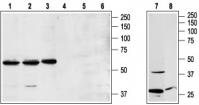NPY1R Rabbit Polyclonal Antibody
Other products for "NPY1R"
Specifications
| Product Data | |
| Applications | IF, IHC, WB |
| Recommended Dilution | WB: 1:200-1:2000; IHC: 1:100-1:3000 |
| Reactivities | Human, Rat |
| Host | Rabbit |
| Clonality | Polyclonal |
| Immunogen | Peptide (C)RLKRRNNMMDKMRDNK, corresponding to amino acid residues 237-252 of human NPY1R. 3rd intracellular loop. |
| Formulation | Lyophilized. Concentration before lyophilization ~0.8mg/ml (lot dependent, please refer to CoA along with shipment for actual concentration). Buffer before lyophilization: Phosphate buffered saline (PBS), pH 7.4, 1% BSA, 0.05% NaN3. |
| Purification | Affinity purified on immobilized antigen. |
| Conjugation | Unconjugated |
| Storage | Store at -20°C as received. |
| Stability | Stable for 12 months from date of receipt. |
| Gene Name | neuropeptide Y receptor Y1 |
| Database Link | |
| Background | Neuropeptide Y (NPY) is a 36-amino acid peptide neurotransmitter in the central (CNS) and peripheral nervous systems. It belongs to the NPY family, together with the peptide YY (PYY) and the pancreatic polypeptide (PP). NPY is involved in regulation of a broad range of homeostatic functions such as eating behavior, hypertension, and reproduction. NPY exerts its effects via five receptor subtypes known as the neuropeptide Y receptors (NPYR): Y1 (NPY1R), Y2 (NPY2R), Y4 (NPY4R), Y5 (NPY5R) and Y6 (NPY6R). Four of these, Y1, Y2, Y4, and Y5, are expressed in humans. The NPY receptors belong to the G protein-coupled receptor superfamily whose members share a common structure of seven putative transmembrane domains, an extracellular amino terminus, and a cytoplasmic carboxyl terminus. Activation of these receptors by NPY produces effects on [Ca2+], adenylate cyclase, and a number of ion channels.Based on the high frequency and density of NPY receptors in steroid hormone-producing tumors, the NPY receptors might be of potential use in tumor management. NPY1R is considered to be a postsynaptic receptor. In the CNS, NPY1Rs are concentrated in the cortical areas of the brain, cerebral cortex, olfactory nucleus, hippocampus, hypothalamic nuclei, and thalamic nuclei. In addition, this receptor has a bimodal role in the immune system, serving as a strong negative regulator on T cells as well as a key activator of antigen-presenting cell function. |
| Synonyms | NPY1-R; NPYR |
| Reference Data | |
| Protein Families | Druggable Genome, GPCR, Transmembrane |
| Protein Pathways | Neuroactive ligand-receptor interaction |
Documents
| Product Manuals |
| FAQs |
{0} Product Review(s)
0 Product Review(s)
Submit review
Be the first one to submit a review
Product Citations
*Delivery time may vary from web posted schedule. Occasional delays may occur due to unforeseen
complexities in the preparation of your product. International customers may expect an additional 1-2 weeks
in shipping.






























































































































































































































































 Germany
Germany
 Japan
Japan
 United Kingdom
United Kingdom
 China
China





